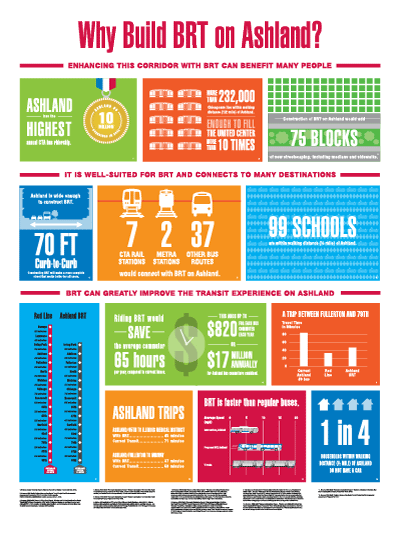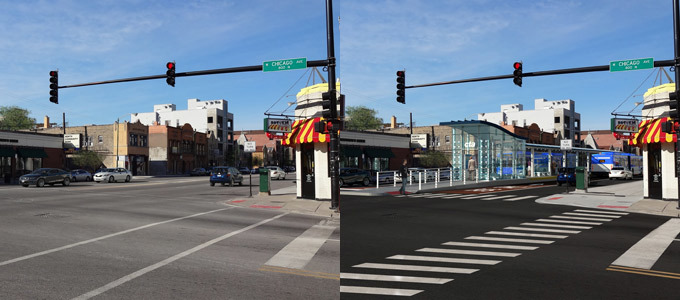We continue to work with the Federal Transit Administration (FTA) to make sure all comments submitted by the public regarding Ashland BRT are fully addressed.
In April 2013, CTA and CDOT announced a vision for a center running Bus Rapid Transit (BRT) system on Ashland Avenue between Irving Park Road and 95th Street to provide a fast and reliable north/south transit connection for 16 miles through Chicago. The vision reflects the planning process and community engagement undertaken in 2012.
Over the summer, CTA and CDOT heard from various key stakeholders about this plan. We then held a public comment period as an extension of this outreach to gather additional input from the public. Two public open house meetings were held on December 10 and 11, 2013 as part of this comment period (see the materials presented at the meeting). CTA and CDOT are still developing the Ashland BRT design, and we are considering options and modifications, including the implementation of additional left turns, based on continued feedback from the public.
The public open house meetings summarized studies of the project impacts, including traffic analyses, which have been performed as part of the formal Environmental Assessment for the project, in accordance with federal government requirements. The Environmental Assessment is now complete and available online.
Although the formal EA public comment period has ended, CTA and CDOT would still like your comments on the Environmental Assessment, which can be e-mailed to [email protected].
CTA and CDOT will consider the results of the analyses, potential impacts and strategies for mitigation, and all public comments before moving forward with the next phase of the project. In addition, there will be additional public input solicited as part of the next design phase.
Detailed information about the project and previous phases of the planning process is included below.
We’ve also developed several videos to explain Ashland BRT and the planning process.
On this page:
Project Overview
The CTA, in partnership with the Chicago Department of Transportation, the Chicago Department of Housing and Economic Development have been pursuing a vision for Ashland Avenue that would provide fast, reliable and convenient transportation. Since 2012, our agencies have worked to develop a long range plan of Bus Rapid Transit along a 16-mile stretch of Ashland from Irving Park to 95th Street. The vision includes dedicated bus lanes, signal priority for buses, limited stops and enhanced customer amenities at bus shelters.
The latest step in this process includes the publication of the Environmental Assessment (EA), which is a document that provides a detailed assessment of social, economic, and environmental impacts of the project, and has been completed for the project, in accordance with federal requirements. CTA and CDOT held a formal public comment period that ended December 20th, 2013, but are still seeking additional public comments on the EA and the project plans (see the Appendix G). Public comments will provide direction on the project’s next phase of design.
 Ashland BRT Corridor Factsheet (text version)
Ashland BRT Corridor Factsheet (text version)
Public Meeting Display Boards (for meetings held December 10 and 11, 2013)
 Boards 1-11
Boards 1-11
 Boards 12-18
Boards 12-18
 Boards 19-34
Boards 19-34
 Text-only version
Text-only version
Videos
What is BRT?
Bus Rapid Transit (BRT) is a term applied to a variety of bus service designs that provide for faster, more efficient and more reliable service than an ordinary bus line. Often this is achieved by making improvements to existing street and traffic signal infrastructure.
Elements of BRT Systems
To get riders to their destinations quickly and on schedule:
- Bus-only lanes
- Transit Signal Priority
- Limited stops
To make it easy to board and keep the bus moving:
- Fares paid at the station before boarding
- Wide doors and/or multiple doors
- Level boarding between bus and curb
To improve the customer and pedestrian experience:
- Stations with enhanced shelters and amenities
- Real-time bus arrival signs
- Streetscaping
Why BRT on Ashland?

View full size (.pdf)
Project Benefits
Saves Time and Improves Reliability
Ashland BRT would provide a transit option about as fast as driving for neighborhood residents, with an increase in bus speeds of up to 83, and a 50 percent improvement in reliability, keeping buses running regularly and on-schedule, and making travel times more predictable.
Increases Opportunities for Economic Development
The Ashland Avenue corridor is a key north-south connector that has seen residential and employment growth and is expected to attract more. According to the Chicago Metropolitan Agency for Planning, the population living within a half-mile of Ashland between Irving Park Road and 95th Street is expected to grow by 55,000 (or about 24%) by 2040. Providing a competitive transit option makes room for economic growth.
BRT has been shown to be an economic driver for a corridor, since it provides fast and reliable transit access similar to rail, which can improve access to jobs, increase foot traffic for neighborhood businesses, attract investment, and spur development.
Meets High Demand
Ashland Avenue has the highest bus ridership of all CTA routes, with 10 million boardings in 2012—more than 31,000 per weekday. Currently, 1 in 4 households located within walking distance of Ashland Avenue do not have a car.
Connects with Major Destinations and Existing Transit Network
The full 16-mile Ashland BRT would connect with seven CTA ‘L’ stations, two Metra stations, and 37 bus routes, and provide a much-needed north-south transit connection outside of the downtown area. This corridor provides access to nearly 133,800 jobs, including large employment centers such as the Illinois Medical District, and serves popular destinations like UIC, Malcolm X College, and the United Center. There are also 99 schools within walking distance of the proposed Ashland BRT.
Improves Neighborhood Streetscape
The proposal to construct BRT on Ashland Avenue includes streetscape improvements that would increase safety and pedestrian comfort, including improved lighting, ADA ramps, platforms that provide pedestrian refuge when crossing the street, and removal of left-hand turns, which are a major cause of vehicle accidents.
How it Works
The configuration for BRT on Ashland (also known as the “Preferred Alternative”) offers riders faster, more reliable service and new, amenity-filled stations with enhanced, landscaped medians between stations and along sidewalks. Local bus service will remain.
The main features include:
- Dedicated center running bus-only lane in each direction to keep buses out of general traffic
- Limited stops: approximately every half-mile and at CTA stations
- Transit Signal Priority intersections and longer green lights to keep traffic moving
- Potential for paying fares at the station before boarding, similar to ‘L’ stations
- Wide doors on left side of new, high-capacity vehicles
- Real-time bus arrival information at stations
- Improved lighting at stations
- ADA ramps at stations
- Maintains most existing medians
- Adds more than 75 blocks of new landscaped medians
- Retains approximately 90% of parking and loading zones on both sides of the street
In order to accommodate BRT, the following adjustments would occur, with some impacts to general traffic:
- Dedicating two general travel lanes (one in each direction) as center-running bus-only lanes, typically leaving one in each direction. Two auto travel lanes in each direction will remain where there are currently three travel lanes (between Lake Street and Roosevelt Road).
- Small reduction in parking; approximately 90% of parking and loading zones retained on both sides of the street.
- Most left turns removed; left turns at highway access points retained.
The Ashland BRT design is still being developed. CTA and CDOT are considering options and modifications, including the addition of some left-turns to the design, and we want your feedback on the current proposal.
How would travel times compare?

Graphic: Travel times shown reflect estimates based on the proposed center running design alternative for Ashland BRT, and Red Line operation during the fastest times of day and with no slow zones along the Dan Ryan branch.
Conceptual Renderings

Before & After: Ashland Avenue at Chicago

Before & After: Ashland Avenue at Polk
Map of Proposed Ashland BRT Stops

This map shows proposed stops along the complete 16-mile Ashland Avenue corridor, and the proposed first phase from Cortland Avenue to 31st Street is shaded in yellow.
Impacts to Traffic
The potential traffic impacts of the project are very important to identify. To better understand these impacts, CTA and CDOT have conducted traffic counts in 2013 and used industry standard traffic models, including the CMAP Highway Model and SYNCHRO, to conduct traffic analysis.
The detailed results of these impact analyses are included in the Environmental Assessment, including impacts to:
- Bus and vehicle speeds
- Congestion levels at specific intersections
- Effects of diverted traffic on nearby roadways
Overall, the analyses showed that:
- The project would have minimal city-wide impacts to traffic
- While there would be some impacts to traffic on Ashland Avenue, the impacts would be moderate
- Some traffic would divert from Ashland Avenue to parallel arterials, but the Chicago grid system provides multiple routes to the same destination, and can absorb changes across multiple parallel arterials, so the impacts would be moderate
- There would be minimal impacts to smaller side streets (non-arterials)
CTA and CDOT will continue working with the community on traffic-related matters through all phases of the project.
Environmental Assessment (EA)
Download the Complete Ashland BRT Environmental Assessment
Ashland BRT Environmental Assessment:
 Full File Size (14 MB)
Full File Size (14 MB)
– this version is a large file size and may take time to download if you do not have a high speed internet connection. Reduced File Size (4 MB)
Reduced File Size (4 MB)
– this version contains all of the same information as the Full File Size version, but some graphics may be lower resolution. Text Version (1.44 MB)
Text Version (1.44 MB)
Appendices to the Ashland BRT Environmental Assessment:
 All of the following links are to PDF documents. Some appendices are divided into several parts because of large file sizes.
All of the following links are to PDF documents. Some appendices are divided into several parts because of large file sizes.
Accessible format versions of the appendices are not available online due to their size. To access an accessible format version of these appendices or if you have other questions related to the accessibility of these materials for the visually impaired, please call 312-681-4279.
See below for locations where hard copies are available.
Frequently Asked Questions about the Environmental Assessment (EA)
What is an Environmental Assessment?
An Environmental Assessment (EA) is a document that summarizes the results of technical analyses and reviews both positive and negative effects of a proposed project on different social, economic, and environmental factors. It considers all options and impacts and allows the CTA to work with communities to create the design that best meets the needs of each neighborhood. An EA allows the FTA to assess any potential impacts in order to determine whether to provide approval to proceed with the project. An EA is required by the FTA for certain types of projects seeking federal funds.
What does the EA for Ashland BRT analyze? What were the findings?
The EA for Ashland BRT documents the full range of possible positive and negative effects of the project along the full 16-mile corridor from Irving Park Road to 95th Street. This process analyzes the impacts of the Preferred Alternative configuration (the “Build Alternative”) as compared to existing conditions (the “No Build Alternative”).
The EA identified potential positive or negative impacts with respect to traffic, parking, neighborhoods and communities, noise and vibration, air quality, energy, and construction.
A summary of the EA findings is included in the Environmental Assessment Summary (.pdf) (text version, .pdf).
How can I see what Ashland BRT would look like on my block?
In conjunction with producing the EA, CTA and CDOT have also been developing conceptual engineering plans, or “concept designs” for the 16-mile Ashland corridor. These are still preliminary, but they include enough engineering detail to evaluate the impacts of the proposed improvements, which are documented in the EA. These concept designs are included as Appendix G.
How to Comment
The formal comment period for the EA has ended, but Wwe want to hear what riders, residents, business owners and others affected by BRT have to say about the project plans on an ongoing basis so that we can consider those needs and concerns as we develop more detailed designs of each section of the corridor. Concept designs are included for review and comment as Appendix G of the EA.
E-mail:
[email protected]
Mail:
Chicago Transit Authority
Strategic Planning & Policy, 10th Floor
Attn: Ashland BRT Project
567 W. Lake St
Chicago, IL 60661-1465
What Will Happen to Your Comments?
- Public comments will help inform the next phase of design. The detailed project plans will be updated based on public input. CTA and CDOT are also committed to additional public meetings as part of the next phase of design.
- Comments received during the official EA comment period (November 19th to December 20th, 2013) and responses to these comments will be available on the CTA website once the review of comments received during the comment period is complete.
- Comments made during the 30-day comment period will become official record for the Environmental Assessment.
- Comments received outside of the formal comment period began will also be taken into account and inform the next phase of design, but may not be included in the official record for the Environmental Assessment.
Public Open House Meetings
Two public open house meetings were held at the following dates and locations. (See materials presented at the meeting.)
Tuesday, December 10, 2013 6:00 - 8:00 P.M.
BENITO JUAREZ COMMUNITY ACADEMY
1450 W. Cermak Road
Chicago, IL 60608
Wednesday, December 11, 2013 6:00 - 8:00 P.M.
PULASKI PARK FIELDHOUSE
1419 W. Blackhawk Street
Chicago, IL 60642
To receive information about future public outreach efforts, please see How to Stay Involved.
How Did We Get Here?
We arrived at the vision for BRT on Ashland after conducting an Alternatives Analysis in 2012, a year-long planning study to assess options for BRT on Ashland and Western Avenues.
During the Alternatives Analysis process, CTA and CDOT conducted technical analysis and held six open houses to garner public input, and additional meetings were held at the request of stakeholders. Dedicating two general travel lanes (one in each direction) as center running bus-only lanes was chosen as the best configuration to address community concerns. This configuration aims to increase bus speeds, enhance streetscapes, preserve medians and parking, decrease congestion and improve safety.
 How We Got Here (text version) – A summary of the project background, process, and Alternatives Analysis results.
How We Got Here (text version) – A summary of the project background, process, and Alternatives Analysis results.
Next Steps
CTA is currently reviewing comments received during the formal comment period, which ended December 20, 2013. See above for more information about the public meetings, how to comment and how comments will be addressed.
The next step is to begin developing detailed designs for the 5.4-mile Phase 1 area, from Cortland Street to 31st Street, taking into account public comments and technical analyses.
There will be further opportunities for public feedback as this project moves forward with the next phase of design. To receive updates, see “How to Stay Involved.”
Project Schedule
| Alternatives Analysis |
2012 |
| Environmental Analysis & Conceptual Engineering |
Spring 2013 – Fall 2013 |
| Detailed Design |
TBD, contingent upon available funding |
All phases listed above include public engagement.
How to Stay Involved
Join Mailing/E-List
E-mail:
[email protected]
Mail:
Chicago Transit Authority
Strategic Planning & Policy, 10th Floor
Attn: Ashland BRT Project
567 W. Lake Street
Chicago, IL 60661-1465
